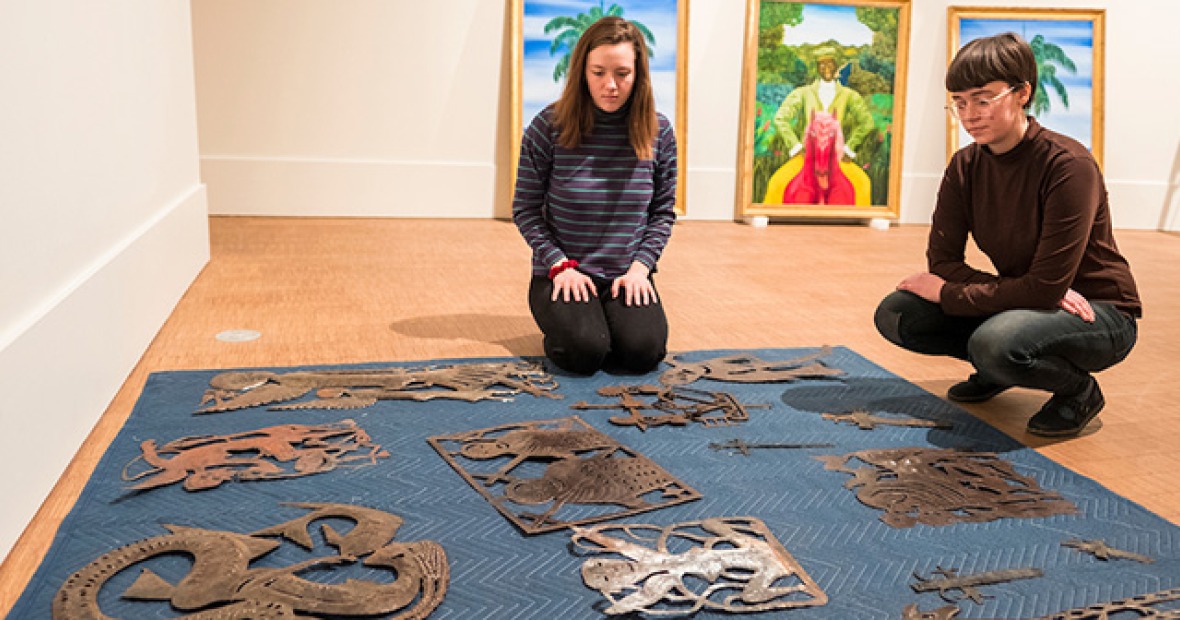Hands-On Seminar + Haitian Art = Awesome Exhibition
Every few years, Grinnell’s art history department offers an exhibition seminar that gives students the opportunity to act as curators for their own art exhibition. They research the themes of the exhibition, design a catalogue, and choose the art to be displayed in Grinnell’s Faulconer Gallery.
“I know of no other school that does a regular exhibition seminar where student research is supported by a partnership between the art history department and the museum,” says Lesley Wright, director of Faulconer Gallery.
This year, the already unique seminar was treated to a historic first: Fredo Rivera ’06, assistant professor of art history, taught the seminar after taking it himself as a student. “I think it was a profound experience that followed me to this day,” he says of participating in the class. “This is the reason we go to Grinnell — to have this very hands-on, intensive experience.”
Connections with Collections
As an expert in Caribbean art, Rivera wanted to take advantage of the fact that Iowa has one of the largest Haitian art collections in the world. He also wanted to take advantage of his close working relationship with Haitian-born artist Edouard Duval-Carrié. So his seminar students were treated to course-embedded travel to museums in Miami and Iowa.
“We were blessed to hire [Rivera], whose research and curatorial interests on the Caribbean complemented my passion for writing and talking about visual culture in Latin America and the Caribbean,” says Abdiel Lopez ’18, a sociology major who participated in the exhibition seminar.
To kick off the semester, the class visited five different institutions in Miami, got a behind-the-scenes look at an exhibition installation, and met with Duval-Carrié in his studio. Then, over fall break, the students spent three days traveling throughout Iowa. They got a behind-the-scenes look at museum collections and were able to go into the vaults at Waterloo Center for the Arts to select works that they wanted to borrow for their exhibition.
Rivera let the students have full control over which artworks they chose. “I think the teamwork really formed at that point, and that’s when they started meeting outside of the class of their own accord.”
“The opportunity to meet museum professionals gave us essential experience in approaching a project of this scale,” says Ellen Taylor ’18, an art history major who participated in the exhibition seminar. “It was especially interesting to observe the approaches of institutions and how their different resources, needs, and goals affected the process of exhibition.”
Student Driven, Hands-On Learning
Over the course of the semester, Rivera also assigned the students readings on Haitian art and history, and they debated the cultural politics of displaying the art respectfully. Some of these readings were the very same papers he had read during his own exhibition seminar — bringing them back and assigning them as coursework in his own class was “very surreal,” he reflects.
“I am one hundred percent sure that we would not have received this wealth of knowledge in a typical art history seminar,” says Lopez, “mainly because we were able to not only talk to professionals who've been in the business for a while but also because we designed this exhibition from beginning to end while reading about Haiti along the way.”
Rivera found himself blown away by the passion and dedication his students applied to their work. “I think the thing that most impressed me is I came into the classroom proposing doing an exhibition on Haitian art with an idea of what the exhibition would be, but as the students engaged with the course material, they took the exhibition to a place that I never thought was possible. I see this as the students’ exhibition — I merely provided connections with collections and a broad idea.”
Rivera’s students also identified and contacted guest speakers (including a vodou priest and assisted in installing the exhibition. Giving the students such a sense of ownership of their work seems to have paid off — several of Rivera’s students have now expressed an interest in becoming curators and furthering their studies of Caribbean art. “This particular exhibition seminar on Haiti has completely altered my professional track,” says Lopez.

